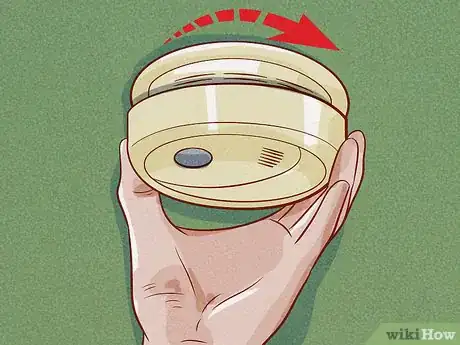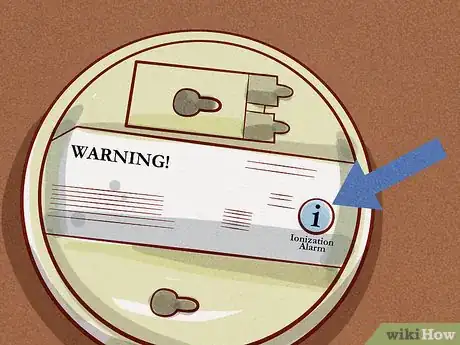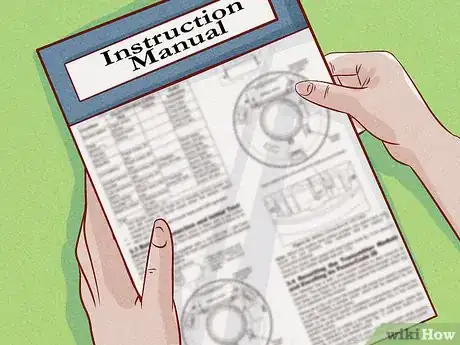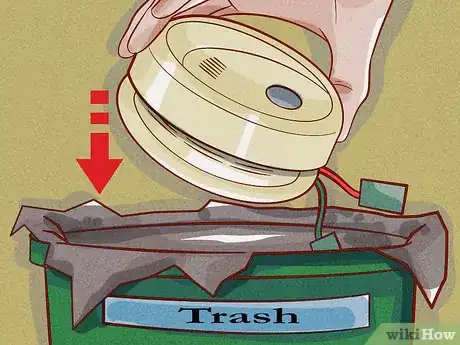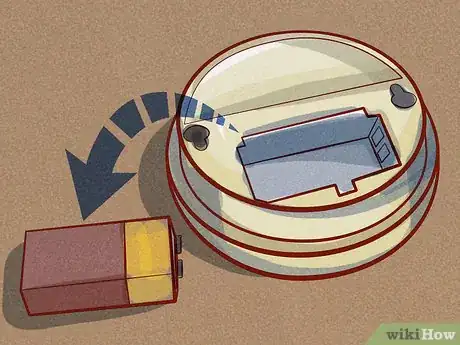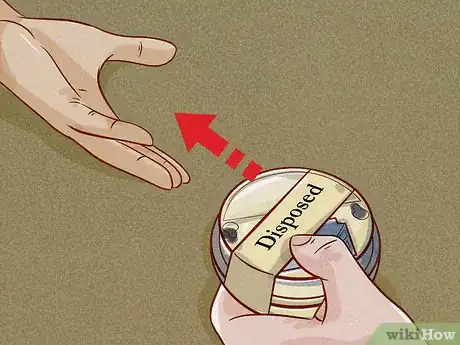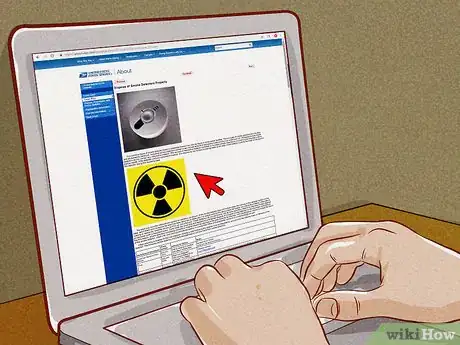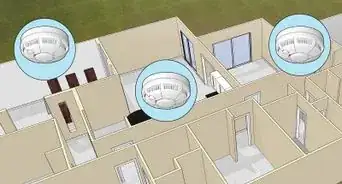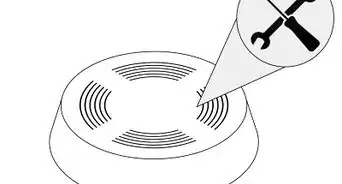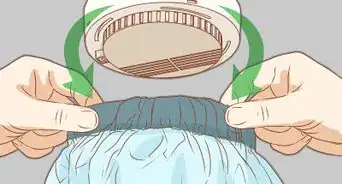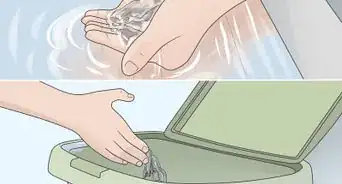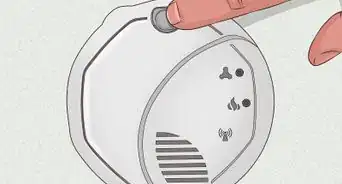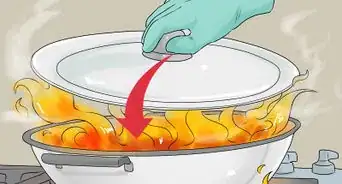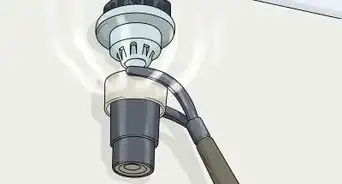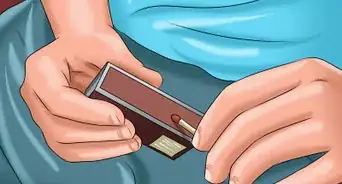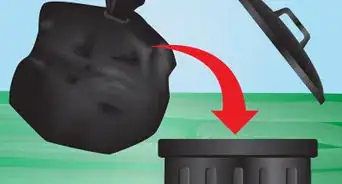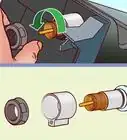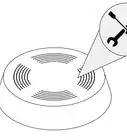This article was co-authored by wikiHow Staff. Our trained team of editors and researchers validate articles for accuracy and comprehensiveness. wikiHow's Content Management Team carefully monitors the work from our editorial staff to ensure that each article is backed by trusted research and meets our high quality standards.
This article has been viewed 43,153 times.
Learn more...
Smoke detectors are an incredibly important addition to any home to reduce the risks of a fire. While changing the batteries can sometimes give new life to a detector, at some point the detector itself will die and need to be disposed of properly. By identifying the type of smoke detector you have, removing it safely, and making sure to take out the battery, you can properly dispose of smoke detectors.
Steps
Identifying Your Smoke Detector
-
1Take the smoke detector off of the mounting. Most smoke detectors can be easily removed from their mounting by twisting them counterclockwise. Use a ladder to safely reach the smoke detector you want to dispose of and twist it to remove it from its mounting plate.[1]
- Some smoke detectors will be removed by twisting clockwise, or will require a screwdriver to disconnect it from the mounting plate. Consult the instruction manual for your smoke detector to find the easiest way to remove it.
- If your smoke detector is mains-powered rather than battery-powered, you will need to turn the main power off at your circuit breaker. If you’re unsure how the smoke detector is powered, find the circuit breaker in your home and switch off the main switch to be completely safe.[2]
-
2Look for a radiation symbol to identify an ionization smoke detector. Most smoke detectors can be classified as either photoelectric or ionization detectors, and need to be disposed of differently. Check the back of your smoke detector for a sticker bearing the radiation symbol to determine which type of detector it is.[3]
- If there is a radiation sticker, or traces of where a radiation sticker may have been on the back of your detector, assume it is an ionization detector. These contain small amounts of Americium 241, which is radioactive. While it is in such small amounts it will not harm you, it means that your detector needs to be disposed of with more care.
- If there is no sticker on the back of your smoke detector, it is very likely a photoelectric smoke detector.
Advertisement -
3Consult the instruction manual if you can’t identify your detector. If you can’t find any identifying symbols on the detector itself, read through the instruction manual for any mention of it being either a “photoelectric” or “ionization” detector. If you don’t have the manual, find the product code on the detector and search it online to find more information.
- As there’s radioactive material involved, it’s very important that you identify your smoke detector properly to prevent harm to yourself and the environment.
- If you cannot find any information on the detector or online, try calling the company that manufactures the smoke detector for more information.
- If you cannot identify your smoke detector, you should treat it as an ionization detector.
Disposing of a Photoelectric Smoke Detector
-
1Remove the batteries from the smoke detector. You should always remove the batteries from any electronics before disposing of them, as the batteries will contain corrosive chemicals that are bad for the environment. Unscrew the battery compartment on the back of the detector and remove any batteries inside to dispose of safely.[4]
- Most battery-powered smoke detectors will be powered by a 9-volt battery. You may need to unplug the end of the battery from a cable in order to remove it properly.
- Even if your smoke detector is mains-powered, it may have a battery installed as a backup power supply. Check the detector for a battery compartment and remove any batteries from it.
- Test the batteries before disposing of them, as they may still work and can be reused in another device or smoke detector.
-
2Find an e-waste recycling center near you. E-waste recycling centers or services take in electronic waste and break it down so that it can be recycled properly. Look online or consult your local phone book to find an e-waste recycling center in your area where you can drop off your smoke detector.
- Some e-waste centers will also offer pick-up services for your electronics, either for free or for a small fee. Look online or call your local e-waste recycling center to find out if this is a service they offer.
-
3Throw away the smoke detector if you cannot recycle it. Not all areas have e-waste recycling centers, and some may not be able to recycle smoke detectors safely. If there is no e-waste recycling center that can recycle your smoke detector nearby, throw the detector away with your regular trash.
- The process for recycling e-waste varies between different electronics, so some centers may not be able to accept smoke detectors if they are not able to recycle them. If you don’t want to throw away your smoke detector, ask the center if there are any other ways that you could have it recycled.
Dispose of an Ionization Smoke Detector
-
1Take the batteries out of your smoke detector. Before disposing of your smoke detector or any other electronics, you should always remove the batteries to keep or dispose of separately. Unscrew the battery compartment on the back of your smoke detector and remove any batteries inside.[5]
- If the batteries still work, you can hold onto them for usage in other devices or in a future smoke detector.
- If the batteries don’t work, make sure to dispose of them safely.
- Smoke detectors which are mains-powered may still have back-up batteries. Check the detector for a battery compartment and take out any batteries.
-
2Return an ionization smoke detector to the manufacturer. The safest and easiest way to dispose of an ionization smoke detector is by allowing the manufacturer to handle it. Look in your instruction manual or online to find the address of the manufacturer. Package the detector securely with a note stating that it needs to be disposed of and send it to the manufacturer.
- Most manufacturer’s of ionization detectors will have a system set up to dispose of the smoke detector easily and within the requirements for handling radioactive waste.
- It may pay to contact the manufacturer in advance before sending the smoke detector.
- In the instance where the manufacturer cannot dispose of the detector themselves, they will return it to you to dispose of.
-
3Consult your local guidelines to dispose of an ionization detector yourself. As ionization smoke detectors contain small amounts of radioactive material, they need to be disposed of in accordance with your local government. Contact the local governmental agency in charge of dealing with radioactive material to find out how to best dispose of it.[6]
- Most countries will have an address where you will be able to send the smoke detector to have it disposed of safely.
- If you’re in the USA, you can find more information about disposal options here: https://about.usps.com/postal-bulletin/2012/pb22334/html/cover_025.htm
- More information on the proper handling and disposal of ionization smoke detectors in the UK can be found here: https://assets.publishing.service.gov.uk/government/uploads/system/uploads/attachment_data/file/383634/JSP392_Lft_18_Smoke_Detectors.pdf
Community Q&A
-
QuestionHow do I dispose of a smoke detector if the company that made it is no longer in business?
 Upnorth HereTop AnswererIf it's an ionization type, or if it has a lithium-ion battery, speak with local waste disposal administrators about it. Otherwise, ordinary e-waste or household waste may be sufficient,
Upnorth HereTop AnswererIf it's an ionization type, or if it has a lithium-ion battery, speak with local waste disposal administrators about it. Otherwise, ordinary e-waste or household waste may be sufficient,
Warnings
- Replace your smoke detector with a functioning one as soon as possible.⧼thumbs_response⧽
References
- ↑ https://www.nfpa.org/Public-Education/By-topic/Smoke-alarms/Installing-and-maintaining-smoke-alarms
- ↑ https://www.familyhandyman.com/electrical/install-new-hard-wired-or-battery-powered-smoke-alarms/view-all/
- ↑ https://about.usps.com/postal-bulletin/2012/pb22334/html/cover_025.htm
- ↑ https://www.businessinsider.com.au/how-to-recycle-batteries-2015-10?r=US&IR=T
- ↑ https://www.businessinsider.com.au/how-to-recycle-batteries-2015-10?r=US&IR=T
- ↑ https://about.usps.com/postal-bulletin/2012/pb22334/html/cover_025.htm
